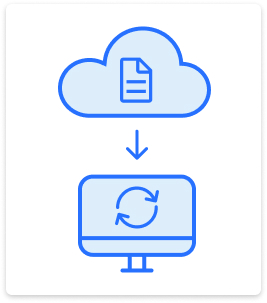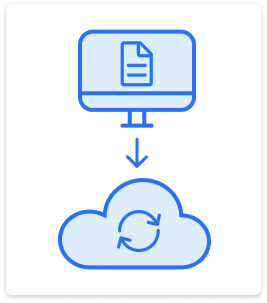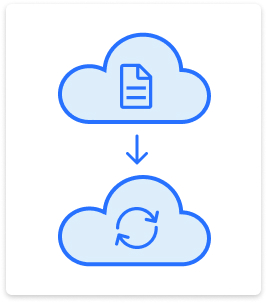For many businesses today, the cloud is an essential component of disaster recovery planning. But integrating cloud-based resources into your disaster recovery strategy can be challenging, because there are so many approaches you can take.
There are multiple ways to benefit from the cloud backup and disaster recovery, as well as multiple strategies for integrating the cloud into such a plan.
Watch this video about Cloud Disaster Recovery
Read on for tips on getting the most out of the cloud as part of your disaster recovery strategy. This article explains how cloud-based environments can support disaster recovery workflows, as well as how to build a plan for disaster recovery in the cloud tailored to your business and compliance requirements.
You can also watch the following video, where we demystify Cloud Disastery Recovery, exploring various cloud-based approaches and offering valuable tips for building a disaster recovery plan that aligns with your specific requirements. Discover how MSP360 can empower you to implement effective CDR strategies and protect your business's continuity.
Cloud Disaster Recovery
Cloud disaster recovery is the process of remediating data and infrastructure to the working state using cloud-based resources. Your organization needs a full-fledged cloud disaster recovery strategy because it ensures business continuity in the event of data loss due to power outages, natural disasters, human errors, or system failures.
There are three basic ways to use the cloud as part of disaster recovery.
Approach 1. Disaster Recovery from the Cloud
 The first is to use the cloud as the place where you store backup data, then recover data from the cloud following a disaster. In this scenario, a cloud site becomes your secondary data center (SDC), since you have a primary data center in your business’s geographical location.
The first is to use the cloud as the place where you store backup data, then recover data from the cloud following a disaster. In this scenario, a cloud site becomes your secondary data center (SDC), since you have a primary data center in your business’s geographical location.
This approach to cloud-based DR allows you to take advantage of the low-cost data storage options available from cloud vendors. It also simplifies your backup routines by allowing you to store backup data from all of your systems in a single location within the cloud.
The downside of disaster recovery from the cloud, however, is that it doesn’t work well if your on-premises IT systems are unavailable when you need to perform disaster recovery. If your local servers and storage media were disrupted by whichever event caused the data loss — which is likely to be the case if, for example, a fire or flood impacted your local data center — you won’t have the infrastructure available to which you can recover data.
Further reading Amazon S3, MS Azure and Google Cloud Storage Pricing Comparison
Approach 2. Disaster Recovery to the Cloud
 A second approach of cloud DR is to back up data on-premises, but recover it to virtual machines and databases running in a cloud platform.
A second approach of cloud DR is to back up data on-premises, but recover it to virtual machines and databases running in a cloud platform.
This approach eliminates the need for physical on-site infrastructure to remain available following a disaster. Instead, you can quickly recover data to virtual environments running in the cloud.
The major risk, however, is that if you store data backups on-premises, your backups may be destroyed if a disaster impacts your local environment.
Approach 3. Cloud-to-cloud Disaster Recovery
 You can achieve the best of both worlds by storing backup data in the cloud and recovering to the cloud at the same time.
You can achieve the best of both worlds by storing backup data in the cloud and recovering to the cloud at the same time.
Under this approach, you would spin up virtual machines and databases in the cloud, then populate them with data from your cloud-based backups in the event of a disaster that impacts on-premises resources.
In addition to separating both your backup data and backup infrastructure from your local data center, this strategy may speed disaster recovery, because it will typically take less time to transfer backup data from cloud storage to cloud VMs and databases than it would to move data between the cloud and an on-premises environment, or vice versa. That’s because networks within the same cloud offer much more bandwidth than the public Internet that connects the cloud to external environments.
The downside of disaster recovery in the cloud is that it is likely to cost the most because it requires you to maintain both backup storage and backup infrastructure in the cloud.
Further reading Building the SMB Backup Infrastructure with Cloud Apps

Configuring Cloud-based Disaster Recovery
That said, you can optimize the business costs of cloud-based disaster recovery by choosing a disaster recovery configuration that is best suited to your needs and budget. There are four basic options to choose from, each of which caters to different recovery time objective (RTO) and recovery point objective (RPO) requirements.
Simple Backup and Recovery
The most straightforward cloud disaster recovery configuration is to back up data from on-premises to the cloud and then recover it from the cloud when needed. This approach will cost the least and is the simplest to administer. The major limitation to consider, however, is whether you’ll be able to move and recover data quickly enough from the cloud to your on-premises environment to meet RTO and RPO needs.
Further reading Full System Backup and Restore Guide
Pilot Light
A “pilot light” disaster recovery configuration involves setting up backup infrastructure (in other words, VMs, databases, and any other resources you require) within the cloud but leaving it turned off until you need it. Because most cloud providers don’t charge for resources that aren’t actually running, this approach allows you to keep costs low while still providing you with the assurance of a ready-to-go, cloud-based infrastructure that you can use for disaster recovery when you need to.
Warm Standby
If you have more budget, you can use a warm standby configuration. In warm standby, you set up a backup environment in the cloud and actually keep it running at all times. That way, you don’t need to waste time starting it up. Warm standby will therefore help you meet tighter RPO and RTO needs.
Multi-site
If you have truly strict RTO and RPO requirements, you may opt for a multi-site cloud disaster recovery configuration. With this approach, you store live copies of backup infrastructure in multiple sites like private and public clouds, and you have remote access to them all the time. By keeping redundant copies of the infrastructure running, you ensure your ability to perform disaster recovery even if one availability zone happens to go down when the disaster occurs. Of course, this configuration also costs the most.
Further reading Multi-Cloud Backup: Avoiding a Single Point of Failure
Cloud Disaster Recovery Planning
When considering the best plan for disaster recovery in the cloud for your needs, then, you should take several factors into account:
- RPO and RTO needs: How long can your business operate without normally functioning systems? The more quickly you need data restored, the more you will probably need to invest in cloud-based disaster recovery that can get your workloads up and running again quickly. It’s vital to perform business impact analysis (BIA) to determine your business requirements and identify exact RPOs and RTOs.
- Cost: The more money you have to invest in cloud backup and disaster recovery, the more sophisticated your cloud disaster recovery plan can be. More financial resources will enable you to take advantage of the warm standby or multi-site disaster recovery configurations described above, which provide faster and more reliable cloud workload recovery, albeit at a steeper price.
- Administration: The more cloud environments and resources you have running as part of your disaster recovery plan, the more time you’ll have to spend managing them (not to mention keeping them secure). Think about how much time your team can afford to spend on administration as you create your cloud disaster recovery plan.

Further reading Disaster Recovery FAQ: Essential Definitions for IT Pros and MSPs
Building a Cloud Disaster Recovery Solution
By putting together all of the pieces described above, you can build a cloud disaster recovery solution that reflects your needs. There are three basic steps to follow here.
Step 1. Choose the Approach
![]() First, determine which approach to cloud-based disaster recovery you’ll take. If you can afford cloud-to-cloud disaster recovery, that may be the best option. But you may also opt for just disaster recovery from the cloud or to the cloud, depending on your RPO needs, the reliability of your on-premises infrastructure, and your budget priorities.
First, determine which approach to cloud-based disaster recovery you’ll take. If you can afford cloud-to-cloud disaster recovery, that may be the best option. But you may also opt for just disaster recovery from the cloud or to the cloud, depending on your RPO needs, the reliability of your on-premises infrastructure, and your budget priorities.
Step 2. Choose the Cloud Vendor
 Whichever parts of your disaster recovery resources you host in the cloud, you’ll need to select the best cloud platform to run them on. A full discussion of this topic is beyond the scope of this article, but you’ll find helpful guidance in our our article about choosing a vendor.
Whichever parts of your disaster recovery resources you host in the cloud, you’ll need to select the best cloud platform to run them on. A full discussion of this topic is beyond the scope of this article, but you’ll find helpful guidance in our our article about choosing a vendor.
Step 3. Choose the Cloud Backup and Disaster Recovery Solution
![]() Finally, you select the backup and disaster recovery software that will back up your data to the cloud and/or recover data from it when the time comes.
Finally, you select the backup and disaster recovery software that will back up your data to the cloud and/or recover data from it when the time comes.
For this need, MSP360 Managed Backup offers unparalleled reliability and flexibility. Because MSP360 supports all of the major cloud platforms, it will work no matter which cloud vendor you choose. In addition, MSP360 provides a range of cloud backup and disaster recovery options, including not just file and folder backup but also image-based backup, which makes it easy to back up entire systems, then restore them quickly to cloud-based VM instances for disaster recovery.





